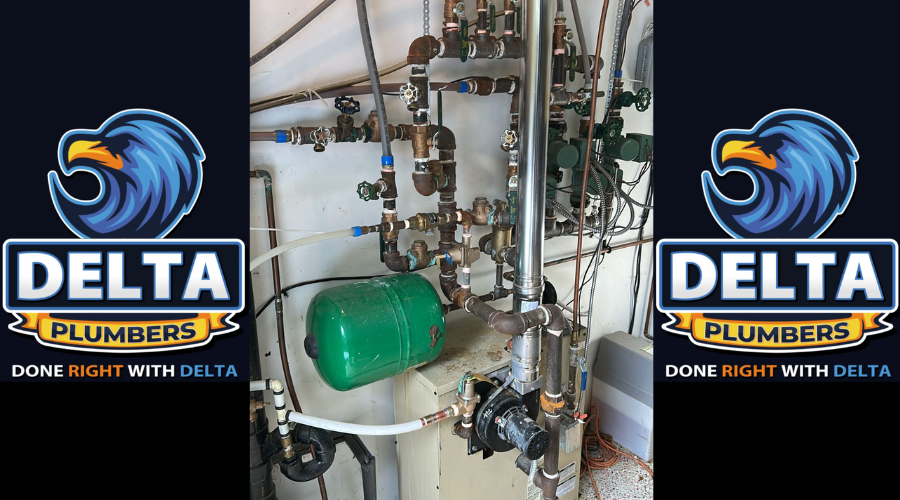The cost of plumbing repairs is expected to rise in 2025, and this trend is being driven by a combination of factors, including inflation, labor shortages, supply chain disruptions, and increased material costs. As plumbing systems continue to age and homeowners face an increase in service demand, understanding the underlying causes of these cost hikes will help homeowners better manage their repair and maintenance expenses. In this blog, we’ll explore the reasons behind the rising cost of plumbing repairs in 2025, how homeowners can prepare, and offer tips to mitigate these expenses.

Picture Source – Delta Plumbers
Why Plumbing Costs Are Rising in 2025
1. Inflation and Its Impact on Service Costs
In 2025, inflation continues to affect almost every industry, and plumbing is no exception. The cost of living increases, which leads to higher wages for plumbing technicians, the rising cost of plumbing repairs includes utilities, and operational overhead for plumbing companies. As plumbing companies are forced to raise their rates to cover these increased costs, homeowners will see an uptick in the price of plumbing services. Additionally, as the cost of living increases, the demand for plumbing services might rise, creating a cycle where both labor and material costs climb.
2. Increased Material Costs
The cost of essential plumbing materials, such as copper, PVC, and PEX pipes, is expected to increase significantly. Copper prices have fluctuated dramatically in recent years, and with its high demand across multiple industries, the price for plumbing copper continues to climb. Similarly, other materials used in fixtures, valves, faucets, and connectors are also more expensive to source, often due to global shortages and tariffs. These rising material costs directly affect the price of plumbing repairs, as plumbing companies pass these costs onto customers.
3. Labor Shortages in the Plumbing Industry
A significant contributing factor to the rising cost of plumbing repairs is a shortage of skilled labor in the industry. The plumbing trade has seen fewer people entering the field due to the high cost of education and training, the physically demanding nature of the work, and an aging workforce. As the demand for plumbing services continues to increase, companies are offering higher wages to attract and retain skilled workers, driving up the overall cost of plumbing services. Additionally, the shortage of skilled technicians means that homeowners may experience longer wait times for service, which can also increase costs for emergency repairs.
Also Read: Tankless Water Heater: Why You Should Upgrade

Picture Source – Delta Plumbers
The Impact of Supply Chain Issues on Plumbing Repairs
1. Global Supply Chain Disruptions
Global supply chain issues that began during the COVID-19 pandemic continue to affect various industries, including plumbing. Disruptions in the supply chain result in delays and price hikes for the materials needed to carry out plumbing repairs. For example, international shipping delays can lead to shortages of key components, such as faucets, pipe fittings, and water heaters, which are often sourced from overseas. When plumbing companies are unable to source parts quickly or affordably, the cost of repairs goes up, and homeowners may be faced with long wait times before repairs can be completed.
2. Delayed Repairs and Emergency Services
The ongoing disruptions in the supply chain can have a significant impact on emergency plumbing repairs. When parts aren’t available or are delayed, homeowners may have to wait for weeks to have their plumbing issues addressed. The longer the wait time for repairs, the more damage that can occur, which could result in more extensive repairs at a higher cost. For instance, a small leak that goes unrepaired for weeks can cause water damage to floors, walls, and ceilings, leading to much higher repair costs than if it were dealt with promptly.
Also Read: Routine Drain Cleaning: Why it is Essential for Your Home.

Picture Source – Delta Plumbers
How Aging Plumbing Systems Contribute to Higher Costs
1. The Dangers of Outdated Plumbing
Many homes, especially older properties, still rely on outdated plumbing systems made of materials like galvanized steel or cast iron. These materials are more prone to corrosion, rust, and buildup over time. As these systems deteriorate, homeowners will find themselves needing frequent repairs, and the cost of replacing these old pipes with newer, more durable materials like PEX or copper can be significant. Furthermore, older plumbing systems are more susceptible to leaks, burst pipes, and blockages, leading to increased repair and replacement costs.
2. The Importance of Regular Maintenance
Proactive maintenance of plumbing systems can help extend their lifespan and prevent costly repairs. However, as plumbing systems age, the cost of maintaining them also increases. Regular inspections, pipe cleanings, and sealing small leaks can help prevent larger issues down the road. As systems continue to age, the repairs needed to maintain them may become more expensive due to the use of newer materials or the complexity of repairing outdated systems.
Also Read: Top Plumbing Problems in Commercial Buildings and How to Solve Them

Picture Source – Delta Plumbers
Labor Costs in the Plumbing Industry
1. Rising Wages for Plumbers
As mentioned earlier, the plumbing industry is facing a shortage of skilled professionals, which is contributing to higher wages for those who are available to work. The rising wages for plumbing technicians are, in turn, increasing the cost of plumbing services for homeowners. When plumbing companies struggle to find enough technicians to meet demand, they must raise wages to attract new workers, and this increase in labor costs directly impacts the price of services.
2. Training and Certification Costs
Another factor contributing to rising labor costs is the expense associated with training and certifying plumbers. Becoming a licensed plumber requires years of education, apprenticeship, and ongoing certification. These expenses contribute to the overall cost of plumbing services, as plumbing companies must factor in the investment required to train new workers. Additionally, specialized training in the latest technologies and plumbing systems increases the costs for plumbing professionals, leading to higher service prices for homeowners.
Also Read: Best Plumbing Services in Ontario: What to Look For

Picture Source – Delta Plumbers
Emergency Plumbing Repairs and Their High Costs
1. The Premium for Emergency Services
Emergency plumbing repairs are typically priced much higher than regular service calls. These premium charges account for the urgency, after-hours work, and the availability of technicians outside of regular business hours. When a pipe bursts or a sewage backup occurs in the middle of the night, plumbing companies need to dispatch workers immediately, which often requires overtime pay and additional resources. Homeowners can expect to pay significantly more for such emergency repairs, sometimes up to three times the normal rate.
2. What Homeowners Can Do to Prevent Emergency Repairs
Homeowners can reduce the likelihood of needing expensive emergency plumbing repairs by performing regular maintenance and addressing minor issues before they escalate. Regular inspections, installing water leak detectors, and keeping an eye on water pressure can prevent plumbing problems from becoming emergencies. Additionally, taking action at the first sign of a plumbing issue, such as a slow drain or minor leak, can help prevent costly repairs down the line.
Also Read: The Health Risks of Ignoring Plumbing Leaks

Picture Source – Delta Plumbers
What Homeowners Can Do to Save on Plumbing Costs
1. Investing in Preventive Maintenance
The best way to avoid high plumbing repair costs is to invest in regular maintenance. Scheduling annual or bi-annual plumbing inspections can identify problems before they worsen, saving homeowners money in the long term. During these inspections, plumbers will check for signs of leaks, corrosion, and buildup, helping prevent unexpected breakdowns that can lead to emergency repairs.
2. Choosing Quality Materials
Opting for high-quality plumbing materials may cost more upfront, but they are often more durable and efficient in the long run. For instance, while PVC and copper pipes may initially seem more expensive than cheaper alternatives, they tend to have a longer lifespan and are less prone to damage. High-quality fixtures and water-saving devices can also reduce utility bills and the need for repairs over time.
3. How to Shop Around for Plumbing Services
To ensure that you are paying fair prices for plumbing repairs, it’s important to compare quotes from multiple licensed plumbing contractors. Be sure to ask for detailed breakdowns of costs, including labor, materials, and additional fees. This allows homeowners to make informed decisions and avoid hidden charges. Additionally, seeking recommendations from friends and family or reading online reviews can help identify trustworthy, cost-effective plumbing services.
Also Read: Is It Time to Replace Your Old Pipes? Signs to Look For

Picture Source – Delta Plumbers
The Future of Plumbing Costs and What Homeowners Can Expect
1. Technological Advancements and Their Impact
As technology advances, new plumbing solutions, such as smart water meters, automated leak detection systems, and high-efficiency appliances, may reduce future plumbing costs. These systems could help homeowners identify problems before they become costly repairs and save on water bills by optimizing consumption. However, the initial cost of installing these technologies may be high, which could contribute to rising upfront plumbing costs.
2. How Sustainability is Shaping the Plumbing Industry
Sustainability trends are also influencing the plumbing industry. New regulations are pushing plumbing professionals to use more eco-friendly materials and technologies, which can sometimes be more expensive. Green plumbing solutions, such as water-saving fixtures and energy-efficient water heaters, are becoming more in demand. While these systems help reduce water consumption and energy costs over time, they can increase the upfront costs of plumbing services.
Conclusion:
As plumbing repair costs rise in 2025, homeowners need to stay informed and take proactive steps to manage their expenses. By understanding the factors driving price increases, such as inflation, labor shortages, and material costs, homeowners can better prepare for higher repair bills. Regular maintenance, investing in quality materials, and making informed decisions about plumbing services can help reduce the long-term impact of the rising cost of plumbing repairs. Being proactive will ensure that your plumbing system remains efficient and your wallet stays protected.









